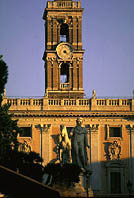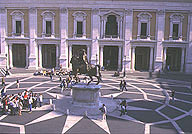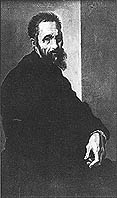Campidoglio Area
Campidoglio
 (Capitolium). From a 12C guide book "Mirabilia Romae":
(Capitolium). From a 12C guide book "Mirabilia Romae":
"The Capitol was the head of the world, where the consuls and senators abode to govern the earth."
And the US Congress building stole its name, the Capitol, from here.
In 1536 Michelangelo designed this magnificent stage set to crown the Capitoline, smallest of Ancient Rome's 7 hills, but the most important since it was the seat of power.
From busy Piazza Aracoeli you mount Michelangelo's graciously sloping stairs (the Cordonato) and step off into the sudden hush of his geometrically-delineated piazza, with his three low and harmonious buildings as a dramatic background.
Michelangelo was inspired by the two millennia of Rome's glorious history that revolved around this hilltop. Being a sculptor, he used it to showcase great Classical Roman statues, notably the equestrian one in the center of Emperor Marcus Aurelius apparently in amicable conversation with the populace.
The Piazza
 In terms of dramatic symmetry, this space of Piazza del Campidoglio is rivaled only by Piazza S. Pietro, which was laid out over a century later by Bernini who was inspired by this masterpiece.
In terms of dramatic symmetry, this space of Piazza del Campidoglio is rivaled only by Piazza S. Pietro, which was laid out over a century later by Bernini who was inspired by this masterpiece.
The square you see today is Rome's first planned piazza. It is just how Michelangelo originally conceived it - except that the Marcus Aurelius statue is a copy, and the original (with its gold leaf partially intact) is inside the Museo Capitolino.
In 1536 there were two existing buildings, the medieval Palazzo Senatorio at the back, and the Palazzo dei Conservatori on the right, projecting out at an acute angle from the first.
Michelangelo drew formal Renaissance facades for both of those, and added the Palazzo Nuovo on the left, a mirror image of the Conservatori, making two symmetrical arms gathering you into Rome's City Center.
![]() Our favorite: the dramatic impact of this room-like ensemble is underlined by the famous trapezoidal markings on the ground, which Michelangelo implanted as if to remind us that this is the center of the world-once and forever.
Our favorite: the dramatic impact of this room-like ensemble is underlined by the famous trapezoidal markings on the ground, which Michelangelo implanted as if to remind us that this is the center of the world-once and forever.
| Capitoline Square History  6C BC. Two centuries after Rome's founding on this and the adjacent Palatine Hill, the enormous Temple of Jupiter was built here, making it the holiest part of this holy city. Traitors were hurled from the hill, including a woman who let the Sabines into Rome. 166 AD. An unknown sculptor produced this bronze equestrian statue of Marcus Aurelius, Emperor and philosopher, in the fifth year of his rule (161-180). He was the Ancient Roman who best typified that perfection we call "the Renaissance Man," and he must have seemed like a brother to Michelangelo fifteen centuries later. Middle Ages. Unlike most similar statues, the bronze Marcus Aurelius escaped being melted down for scrap by the Popes. Thinking it was Constantine the Great, Rome's first Christian emperor, they placed it beside Rome's Cathedral, St. John of Lateran. 1536. Pope Paul III Farnese decided to flatter the Holy Roman Emperor, Charles V, by according him a triumphal procession of the kind enjoyed by the victorious generals of ancient Rome. Charles had just triumphed over the infidels in North Africa, but the wily Pope probably seized the opportunity in order to placate this natural enemy of Papal power, the Holy Roman Emperor. It also served to efface memories of the Sack of Rome of 1527 when Charles' troops defeated and imprisoned the previous Pope, Clement VII Medici. Embarrassed by the wretched appearance of Rome, Pope Paul asked Michelangelo, who was busy painting the "Last Judgment" in the Sistine Chapel, to beautify the final destination of the Emperor's triumphal procession, the Capitoline hill, (which for good reason was then known as the "Hill of the Goats"). The only part of Michelangelo's grand design that was ready in time for the imperial Triumph was the graceful base he sculpted for Marcus Aurelius and his horse. His revolutionary plan turned the square's entrance toward St. Peter's. 1564. Michelangelo died, and only the double staircase at the back of the square had been built. The other elements of his master plan were finally completed a couple of centuries later. |
Palazzo dei Conservatori
Is located on the right - or river side - of the square, as you face the Senator's Palace. Your ticket is valid for this museum as well as its twin on the other side of the square.
The first thing that meets the eye is the gargantuan head, knee, leg, hand, arm, and two feet in marble, from the statue of Constantine the Great. This used to preside down on the Roman Forum in his Basilica (Maxentius started the building, Constantine killed him and finished it).
The dressed parts of the body were in wood covered in gilded bronze, and have been lost in the mists of time. The figure seated measured 12 meters/yards high. The other large head and hand you see are probably of his son Constantius II.
On the left are bas-reliefs from Hadrian's Temple showing the foreign provinces. Above these is an inscription from 51 AD about Emperor Claudius' conquest of Britain.
| Palazzo dei Conservatori History Middle Ages. The Magistrates' Chambers and Halls. 1450. Pope Nicolas II Parantucelli built a new palace for these public halls. 1471. This building was used to house the extraordinary gift of ancient bronze statues given by Sixtus IV della Rovere to the people of Rome, making it the first public museum in the world. 1561. The facade was remade in accordance with Michelangelo's plan. 1801. Napoleon stole many ancient statues for the Louvre. 1821. When the statues were returned, the building was restored. Today. Municipal Registry. (Do you want to get married?) |
Piazza del Campidoglio ( Map H I - 6 7)